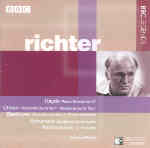Since his death, Sviatoslav Richter has emerged as the Grateful Dead of classical pianists. Wherever he played tape recorders followed, and, well, you know the rest. Numerous posthumous releases continue to compound and complicate the pianist’s overstuffed discography. That doesn’t stop Richter mavens from debating the relative merits of his countless recorded versions of this or that work, much as Deadheads pore over concert setlists and vote for their favorite “Dark Star” or “Playing in the Band”. That said, Richter is largely on top form in these 1967-69 performances, and selections that have previously appeared on pirate labels benefit from BBC Legends’ superior sound.
The Haydn E minor Sonata is a marvel: the runs and unexpected silences are timed to perfection and the dynamics are impeccably scaled. No significant interpretive variables occur between the pianist’s live 1968 Beethoven Op. 22 and his Philips studio version from five years earlier, save for harder-hitting accents in the 1963 first movement and a more flowing melodic impetus in the live slow movement. I do prefer, though, the stark spaciousness of this 1967 Chopin Op. 72 No. 1 Nocturne over Richter’s more compact 1972 Praga reading.
The unrelenting force and monumental power Richter brought to his 1970 studio Beethoven Eroica Variations is ever present in this 1968 live account, but with more color and dynamic variety. In the heat of the moment, Richter omits the 12th variation’s first-half repeat. Richter’s live 1968 Schumann Symphonic Etudes follow the same interpretive and textual game plan as his extraordinary 1971 studio version. He places all five posthumous variations together at midpoint and plays them more flexibly in front of an audience. On the other hand, he overshoots his mark at the beginning of Etude V, flubbing the dotted rhythms that he handles with ironclad aplomb in the studio.
Richter’s lucid and transparent Rachmaninov Preludes make almost everyone else’s sound thick and doughy. To choose between the group of 12 played at a 1969 Manchester recital and their studio counterparts from two years later is to split hairs. The live G minor Prelude (Op. 23 No. 5), however, begins deliberately and speeds up, whereas the studio version maintains a stricter basic pulse. And the studio environment ensures more opportunity for accuracy in the Op. 23 No. 2 Prelude’s taxing climactic chords than does the “non-take-two-ness” of the concert hall. Lastly, Richter floats the outer sections of Chopin’s F major Nocturne (Op. 15 No. 1) in brooding arches while magnifying the middle section’s vehement anguish. This may not be so essential as other Richter releases in this series, but it’s still worth hearing.
































